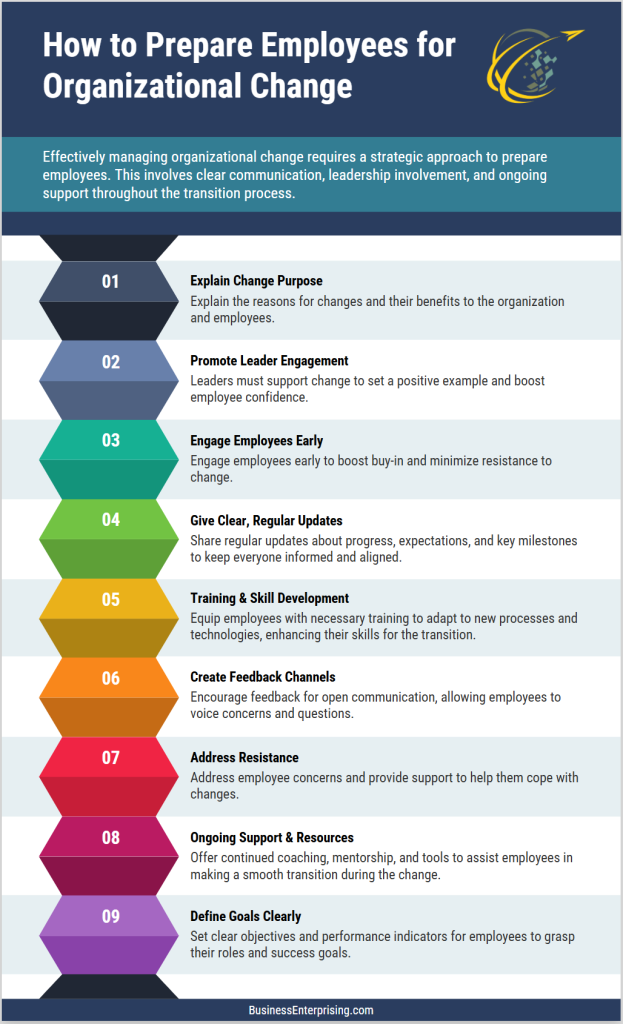 Organizational change is a constant in today’s business environment. However, guiding your team through transitions can be challenging. Preparing employees for organizational change is essential for maintaining productivity and morale. By implementing effective strategies, you can help your team adapt and thrive during periods of change. Below, we’ll explore some approaches to support your employees through organizational transformations.
Organizational change is a constant in today’s business environment. However, guiding your team through transitions can be challenging. Preparing employees for organizational change is essential for maintaining productivity and morale. By implementing effective strategies, you can help your team adapt and thrive during periods of change. Below, we’ll explore some approaches to support your employees through organizational transformations.
Understanding the Need for Change
Understanding the need for change is essential when preparing employees for organizational change. Change is necessary for organizations to remain competitive and adapt to evolving market conditions. By aligning change initiatives with your business goals, you create a clear sense of purpose for your team. This alignment helps employees see how their efforts contribute to the company’s success.
When employees comprehend the reasons behind change, they are more likely to support and engage with new initiatives. Clear communication about how change aligns with organizational objectives fosters a shared vision. Consequently, this shared understanding can lead to increased motivation and productivity. Therefore, it’s important to involve your team in discussions about change to build commitment.
Additionally, linking change to specific business goals provides measurable targets for success. These targets offer employees a framework to assess progress and understand the impact of their work. This clarity not only guides their efforts but also reinforces the importance of their roles within the organization. As a result, employees can better appreciate the necessity of change and their part in driving it forward.
Effective Communication Strategies
Effective communication strategies are essential when preparing employees for organizational change. Transparent communication provides clarity, reducing uncertainty among your team members. By openly sharing information, you build trust and foster a sense of inclusion. Consequently, employees feel more secure during transitions.
Consistent messaging ensures that everyone receives the same information, minimizing confusion. Regular updates keep your team informed about progress and expectations. This consistency reinforces stability, helping employees adjust to new developments. Therefore, maintaining uniform communication is crucial.
Two-way communication channels encourage employees to voice their concerns and provide feedback. By actively listening, you validate their feelings and gain valuable insights. This dialogue promotes collaboration and eases resistance to change. Additionally, it empowers your team to participate in the process.
Incorporating transparent, consistent, and two-way communication can significantly ease concerns during organizational transitions. By adopting these strategies, you build trust and facilitate a smoother change process. Ultimately, effective communication lays the foundation for successful transformation.
Employee Involvement and Engagement
Involving employees in the change process is essential for preparing employees for organizational change. When you actively engage your team, they develop a sense of ownership over the transition. This involvement fosters commitment and reduces resistance. Consequently, employees are more likely to support new initiatives.
Additionally, including employees in decision-making enhances job satisfaction and motivation. By valuing their input, you demonstrate trust and respect. This approach leads to increased personal investment in the organization’s success. Therefore, engagement not only benefits employees but also drives positive outcomes for your company.
Moreover, engaged employees are better equipped to adapt to new roles and responsibilities. Their active participation in the change process allows them to anticipate challenges and develop solutions collaboratively. As a result, the organization becomes more agile and resilient during transitions. Thus, fostering employee involvement is a strategic approach to managing change effectively.
Training and Skill Development
Equipping employees with the necessary knowledge and skills is essential when preparing employees for organizational change. Implementing comprehensive training programs ensures your team can adapt to new processes effectively. By investing in skill development, you enhance both individual and organizational performance.
One effective approach is on-the-job training, where employees learn by engaging directly with their tasks. This hands-on method allows for immediate application of new skills, facilitating quicker adaptation. Additionally, it provides real-time feedback, enabling employees to adjust and improve promptly.
Another valuable method is e-learning, which offers flexibility and accessibility. Employees can access online courses at their convenience, accommodating different learning paces. This approach supports continuous learning and skill enhancement, crucial during transitions.
Furthermore, mentoring programs pair less experienced employees with seasoned colleagues. This relationship fosters knowledge transfer and provides support during change. Consequently, employees gain confidence and competence in new processes.
By implementing these training strategies, you prepare your team to navigate organizational changes successfully. Investing in skill development not only aids in the current transition but also builds a resilient workforce ready for future challenges.
Managing Resistance to Change
Managing resistance is essential when preparing employees for organizational change. Anticipating resistance allows you to address concerns proactively. By expecting pushback, you can develop strategies to mitigate it effectively. This approach fosters a smoother transition.
Open communication plays a crucial role in easing resistance. Encourage employees to express their concerns and listen actively. This dialogue builds trust and uncovers underlying issues. Consequently, you can address problems before they escalate.
Involving employees in the change process increases their commitment. When team members participate in planning and decision-making, they feel valued. This inclusion reduces resistance and promotes a sense of ownership. Therefore, engagement is key to successful change.
Providing adequate training and support helps employees adapt. Equip your team with the necessary skills to navigate new processes. This preparation boosts confidence and reduces anxiety. As a result, employees are more likely to embrace change.
Recognizing and rewarding adaptability reinforces positive behavior. Acknowledge employees who demonstrate flexibility during transitions. This recognition motivates others to follow suit. Consequently, a culture that embraces change develops.
By implementing these strategies, you can manage resistance effectively. Proactive planning, open communication, and employee involvement are crucial. Additionally, providing support and recognition fosters a positive mindset. Together, these approaches facilitate successful organizational change.
Providing Ongoing Support and Feedback
Providing ongoing support and feedback is essential when preparing employees for organizational change. Continuous support helps employees feel valued and understood during transitions. By offering regular assistance, you address concerns promptly, fostering a sense of security. Consequently, employees are more likely to embrace change.
Establishing feedback loops encourages open communication. When employees can share their experiences and suggestions, it promotes a culture of collaboration. This dialogue allows for real-time adjustments, ensuring the change process aligns with team needs. Therefore, feedback loops are crucial for successful change initiatives.
Leadership involvement plays a significant role in sustaining change. Active participation from leaders demonstrates commitment and sets a positive example. By engaging with employees, leaders build trust and motivate their teams. As a result, the organization navigates change more effectively.
In summary, continuous support, open feedback, and strong leadership are key to managing organizational change. These elements work together to create a supportive environment. By focusing on these areas, you can guide your team through transitions successfully.
Conclusion
Successfully preparing employees for organizational change involves several key strategies. First, clearly communicate the reasons behind the change and how it aligns with business goals. This transparency fosters understanding and acceptance. Additionally, involve employees in the change process to increase their commitment and reduce resistance.
Providing adequate training and resources equips your team with the necessary skills to adapt to new processes. Furthermore, managing resistance through open dialogue and addressing concerns promptly is essential. Finally, offering ongoing support and feedback ensures that employees feel valued and guided throughout the transition. By implementing these strategies, you can facilitate a smoother transition and achieve successful outcomes.



